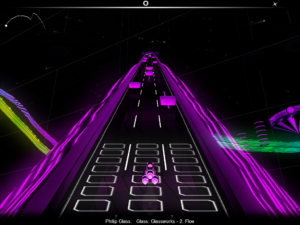Audiosurf
At a casual glance, Audiosurf looks a lot like an early Harmonix game, like Frequency and Amplitude: the player drives a little spaceship down a twisting multi-lane highway in an abstract environment, trying to hit colored spots in time with the music. But the similarities end there. Harmonix, even in the days before Guitar Hero, has always been about capturing the feeling of performing music. The player’s goal in their games is to add something to the soundtrack, to build up a piece of music note by note, by hitting the right buttons at the right moments. In Audiosurf, the music is there regardless of what you do, and buttons are strictly for voluntary use of special powers not directly related to the music. You don’t even necessarily want to activate all of the colored spots, like you would for a perfect performance. That’s because you’re not in any sense performing the music. You’re reacting to it.
Or, to be precise, you’re reacting to the level design, which is generated automatically from the music. Procedural generation of game content from music has been done before — Vib Ribbon, released in 1999, may be the earliest released example, but it came too soon to take advantage of ubiquitous networked digital distribution of music the way that Audiosurf does, providing built-in iTunes and Last.fm integration, as well as a small weekly roster of songs to download from the Audiosurf servers. (As I write this, it’s Jonathan Coulton week.) Not that you’re limited to this content; any song you have in a DRM-free format is useable, provided it meets certain requirements such as a minimum length.
And that’s a snag for such as me. This game is really meant for playing with your own music collection, and I don’t own a lot of music. I never went through a music-collector phase like most people; my collector instincts attached themselves to games instead. I have a handful of CDs left over from my college days, back when people still bought CDs: several They Might Be Giants albums, some Satie and Prokofiev and Philip Glass. I have a few recordings of bands that friends of mine were in. And I have the DROD soundtrack CD. This is little enough that I don’t even really consider it representative of my own musical tastes. Still, there are a bunch of songs there that I haven’t listened to in a long time, and this is as good an excuse as any to drag them out.
So, how well did it handle the music I had available? It varies. It’s probably at its best with dance music, or things resembling dance music. Playing Satie’s piano works, mainly quiet and slow things, the burbling electronic sound effects of the game itself felt very weird; I suppose I could turn them off, but then I’d lose a valuable channel of feedback. Moreover, the whole way it detects the tempo and intensity of the piece seems tuned more for the way pop music works than for classical-ish stuff. For example, in one of the Glass pieces, a very steadily-paced work throughout, the path tilted straight downward simply because a bassoon joined in. This is supposed to be what happens in more intense sections; sedate stuff has the path tilting upward. (Why not upward for rising tension? Because the slope determines how well you can see what’s ahead of you. Downward slope means limited visibility.)
Still, some of the less modern stuff works well. The “Montagues and Capulets” theme from Prokofiev’s Romeo and Juliet — you’d probably recognize it if you heard it — made the road satisfyingly bumpty in just the right places. And sometimes even TMBG was awkward, as in the opening of Ana Ng: the speed at which you go down the road varies with the music volume, and the unnaturally sharp and echoless cut-offs here made the vehicle jerk and judder like it was having engine trouble.
 I think the most satisfying ride I’ve had yet was in Floe, by Philip Glass. It’s almost like he wrote it with Audiosurf in mind. I mean, just look at that intensity graph in the upper left of the screenshot. (You’ll have to click on it to see it; it’s invisible in the thumbnail.) Most songs have spiky and irregular graphs, but here, it looks like it’s made of circular arcs. The effect on gameplay is a smooth progression from easy to difficult.
I think the most satisfying ride I’ve had yet was in Floe, by Philip Glass. It’s almost like he wrote it with Audiosurf in mind. I mean, just look at that intensity graph in the upper left of the screenshot. (You’ll have to click on it to see it; it’s invisible in the thumbnail.) Most songs have spiky and irregular graphs, but here, it looks like it’s made of circular arcs. The effect on gameplay is a smooth progression from easy to difficult.
According to the leaderboards, only four other people have tried that song. Most of my songs, no one else has ever tried. But that might be misleading: there may be other people playing Prokofiev, but they wouldn’t show up as competing with me if they’re playing a different recording. (And quite right, too: different performances could vary the level design in nontrivial ways.) This is another way in which my music collection isn’t ideal for the game. But I suppose it could be worse. With the company I kept in college, I could have easily wound up a fan of Karlheinz Stockhausen. In fact, I’m kind of tempted to download some of his stuff to see how well the game copes with it.
 Comments(2)
Comments(2)
There’s a certain joy to trying to find pieces of music sufficiently obscure that no one else has played it in Audiosurf – at least in your chosen difficulty.
It’s the only way I’m ever likely to get the highest score for anything.
[…] Featured image from Wurb […]